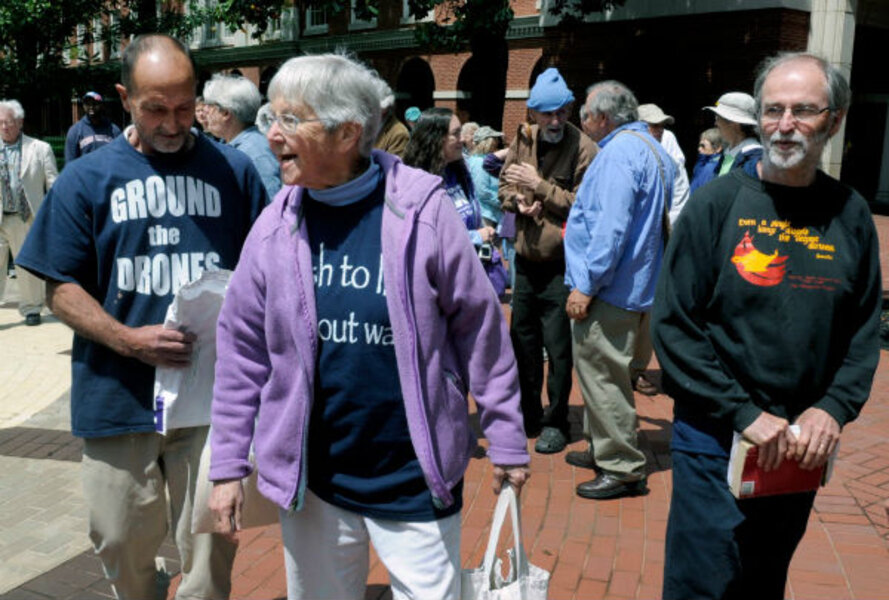Nun sentenced to 35-months in prison for antinuclear peace protest
Loading...
Megan Rice, an octogenarian nun and seasoned peace activist, was sentenced to 35 months in prison after breaking into the grounds of a nuclear weapons complex once considered the "Fort Knox" of weapons-grade uranium.
Federal District Judge Amul Thapar sentenced the Catholic nun to 35 months in prison Tuesday for sabotage at the Y-12 National Security Complex in Oak Ridge, Tenn., on July 28, 2012. Fellow protesters Greg Boertje-Obed and Michael Walli each received sentences of 62 months in prison, less than the federal guidelines of six-to-nine years.
The three have been awaiting sentencing since being convicted of sabotaging the plant and damaging federal property last year. Three weeks ago, Judge Thapar ordered the three to pay $52,953 in fines but had to postpone sentencing due to a snowstorm.
"Please have no leniency with me," Sister Rice told the judge in her closing statement. "To remain in prison for the rest of my life would be the greatest gift you could give me."
The nun and her two accomplices broke into the facility grounds by cutting through three fences with bolt cutters and sneaking past dogs and armed guards and a sign warning that trespassers risk becoming subject to deadly force. Once inside, the protesters splattered human blood on the wall of a $548 million storage bunker containing much of the nation’s bomb-grade uranium, spray painted Biblical slogans of peace, and defaced the exterior of the complex with a hammer.
"The protesters put themselves at a high risk of losing their life in performing this act," a National Nuclear Security Administration spokesman has said. "We are thankful that did not occur."
The three activists managed to spend more than two hours inside the restricted area before guards found them singing and hanging banners. The three reportedly invited the guards to break bread with them and offered the guards a Bible, candles, and flowers.
“We believe Christians have a duty of public witness against nuclear weapons,” Mr. Boertje-Obed of Duluth, Minn., wrote in a letter from the Ocilla, Ga., jail where he and his co-conspirators have been held since May, Religion & Politics reports.
Peace activists in the United States and around the world have engaged in nuclear weapons protests since the 1940s and '50s. The June 12, 1982, march and rally for peace and disarmament drew nearly 1 million protesters to New York City’s Central Park in one of the nation’s largest political demonstrations in history.
Religious groups have played a major role in many antinuclear weapons protests over the years. In the early 1980s, American Catholic Bishops, the Southern Baptist Convention, the Episcopal Church, and the Central Conference of American Rabbis all issued public statements denouncing the use of nuclear weapons.
“American faith communities’ track record on opposing nuclear weapons is so far reaching and strong that it’s fair to say faith-based rejection of the development, deployment, targeting, and use of nuclear weapons is one of the most widely shared convictions across faith traditions,” writes the Rev. Dr. Susan Brooks Thistlethwaite in a 2010 article for the Center for American Progress.
Such protests include:
• In March 2013, 37 antinuclear weapons protesters were arrested during an annual Good Friday, antinuclear weapons demonstration outside the Lawrence Livermore National Laboratory in Livermore, Calif, according to a joint report from CBS and the Associated Press.
• In July 2013, 23 people, including Carl Kabat, a 79-year-old Catholic priest who has spent 17 years in jail for antinuclear weapons protests, were arrested after crossing the property line into a new nuclear weapons complex, according to National Catholic Reporter.
• In 2003, three Roman Catholic nuns were sentenced to two-to-three years in prison for defacing a Colorado nuclear missile silo with their own blood.
Sister Rice has been arrested between three and four dozen times for acts of civil disobedience, The New York Times reports.
This incident sparked particular ire among federal officials because it shed a glaring spotlight on major security failures at a facility that is supposed to be the “Fort Knox of uranium.”
The Associated Press and Reuters contributed to this report.








